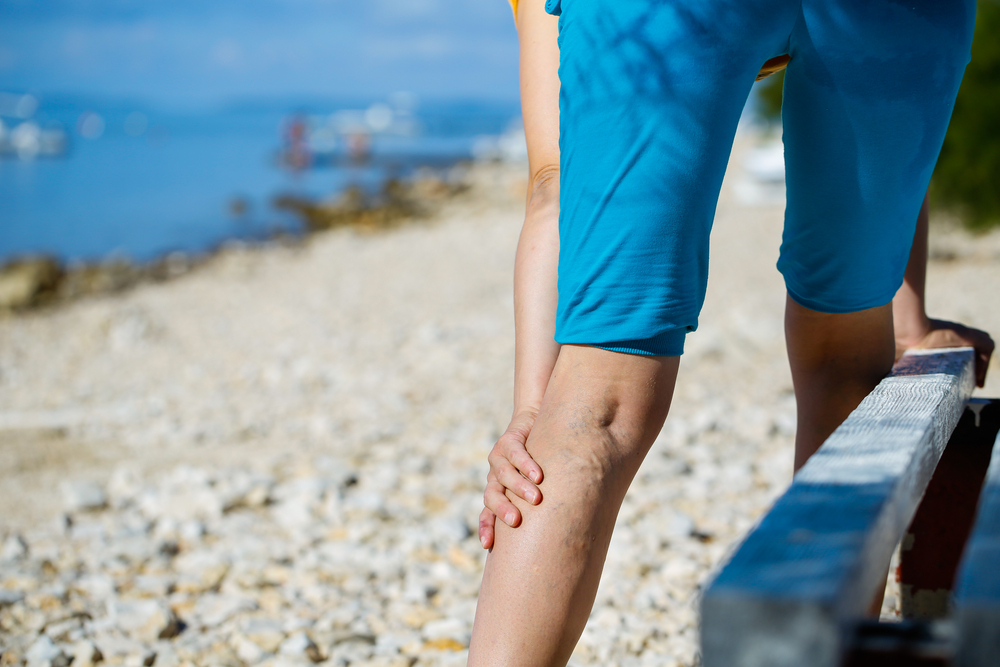Sclerotherapy is the gold standard in treating both spider veins and varicose veins. While spider veins most often cause only cosmetic concerns, varicose veins can cause serious concerns, including future medical conditions. Today, the experts at ReflectionsMedical Spa in Cartersville, GA reveal how long the results of treatment normally last, how you can mitigate your risk of future problems, and whether you may be a good candidate for treatment.
How Long Does Sclerotherapy Last?
The results of sclerotherapy are permanent. During treatment, a sclerosant is injected into the walls of the affected veins. The sclerosant irritants the venous walls until they collapse. Once the venous walls collapse, no blood can pass through the vein. With no blood passing through the collapsed vein, the vein starves. Eventually, it is absorbed by the surrounding healthy tissues and is no longer visible through the skin.
How Long Will It Take to See the Final Results?
You will notice immediate relief from discomfort once your treatment session is over. However, you’ll still be able to see the tangled veins. It can take anywhere from three to 12 weeks for the treated veins to disappear completely. Usually, it takes somewhere between three and six weeks for your body to absorb treated spider veins; varicose veins are usually absorbed fully within nine to 12 weeks.
How Many Sessions Will I Need to Achieve My Desired Results?
If you’re looking to treat spider veins, you will only need one session to destroy the disordered vein fully. Small varicose veins can also be destroyed completely after just one treatment session. This question becomes more difficult to answer in cases of large varicose veins deep beneath the skin’s surface in multiple regions of the body.
If you have a large, deep cluster of thick, gnarled varicose veins, you may need two sessions to destroy the veins completely. You may need to come in for a follow-up appointment eight weeks after your first session to determine whether the treated varicose veins will continue to fade with time or more sclerosant is needed.
How Long Does a Treatment Session Last?
How long your treatment session will last primarily depends on the number of veins you’re treating, the type of veins you’re treating, and where they are located. If you are seeking sclerotherapy to treat spider veins that are close to the surface of the skin and do not have blood clots attached to the outside of the vein, your session should only last around 15 minutes.
Unfortunately, due to their size and location, varicose veins are much trickier to treat. Typically, it takes around half of an hour to treat complex cases of crinkled veins. If you need to treat large, severely twisted varicose veins in several regions of your body, like your lower legs and abdomen, your treatment session may take an hour or longer. We’ll give you a better idea of how long your treatment should take during your consultation.
How Long Does It Take to Prepare for Treatment?
Due to the non-invasive nature of this treatment, you only need four days to prepare. The most important thing you can do to prepare for your treatment is to buy a prescription-strength compression garment and wear it for the four days leading up to your treatment. You must wear a compression garment for a week or two after your treatment, so it is important that you get used to putting one on and wearing it.
Since there is no general anesthesia involved in this treatment, there is no need to fast in the 12 hours leading up to it. In fact, we strongly encourage you to eat a dinner loaded with colorful veggies and a large portion of lean protein the evening before your appointment. Your breakfast (and lunch if you have a late appointment) should also incorporate lots of produce and protein. Finally, get a good night’s rest and wear comfy clothes to your session.
What Downtime Can I Expect After Treatment?
Since this is a non-invasive treatment, there is almost no downtime associated with this treatment. For example, you are free to return to work immediately after treatment if you have a sedentary job. However, there are a few aftercare steps that you must adhere to. We’ll give you a full run-down during your consultation, but here’s a highlight of the most important things you need to do:
Wear a compression garment for a week or two
Protect yourself from UV exposure for one month
Walk regularly
Drink at least half of a gallon of water per day
Avoid intense physical activity for one week
Avoid excessive heat for one week
What Can I Do to Minimize My Risk of Developing Future Disordered Veins?
Spider and varicose veins sometimes occur due to simple bad genes. However, most of the time, disordered veins are caused by one’s lifestyle; this can be changed to minimize the risk of developing disordered veins in the future. Here is a brief overview of some lifestyle changes you may want to make to minimize your risk of developing disordered veins in the future.
Meet AHA Activity Guidelines
Both spider and varicose veins are often caused by poor circulation. A multitude of factors affects circulations. One of the simplest things you can do to support a strong circulatory system is to meet the American Heart Association’s activity guidelines. According to the American Heart Association, adults should get at least 2.5 hours of moderate exercise weekly. If you don’t have 2.5 hours a week to work out, you should get 1.25 hours of intense exercise.
Moderate exercise is defined as exercise performed at an intensity that keeps your pulse between 50 and 70% of its limit. Intense exercise is defined as physical activity that keeps your heart rate within 70 to 85% of its limit. To calculate your maximum heart rate, subtract your age from 220. If you are 39 years old, your maximum heart rate is 220-39, or 181 beats per minute (BPM). During moderate exercise, your pulse will be around 90 to 128 BPM.
Move More
While regular exercise is great for supporting a strong circulatory system, it’s not the only important thing you can do. Research has shown that moving around regularly is a great way to keep your blood flowing and mitigate the risk of developing disordered veins in the future. If you have a job that requires you to stand in one place for several hours, try to walk around or do brief calisthenics every hour. If you can’t, move around every hour at home.
Similarly, if you have an office job, set a timer on your phone and make a point to get up and walk hourly for just a bit. If you don’t need to use the restroom, make a coffee or check the fax machine, do brief calisthenics, like 60 seconds of squats. You’ll mitigate your risk of developing disordered veins in the future, and you will be amazed by the improvement in gluteal muscle tone if you make a point to squat several times per week.
Drink More Water
Hydration plays a very important role in the health of your circulatory system. When you are dehydrated, your blood is thicker, thus harder to return from your legs to your heart. Furthermore, dehydration can lead to severe muscle tissue cramping. This chronic cramping can lead to swelling, putting excess pressure on the veins and further decreasing the efficiency of the circulatory system.
Everyone has different hydration needs, but a good general rule of thumb is men should consume roughly 15.5 cups of fluids daily. Women should consume approximately 11.5 cups of water per day to maintain adequate hydration. Keep in mind, if you are fairly physically active or weigh more than the average person, you may need to drink more hydrating fluids. Gauge your hydration by checking to see if your urine is translucent or extremely pale.
Am I a Good Candidate for This Treatment?
Just as exciting as how long this treatment lasts is that nearly everyone is a good candidate for this non-invasive treatment. If you are fairly healthy and have spider veins or varicose veins, there is a very good chance that you are a good candidate for treatment. There are very few medical conditions that preclude you from treatment. Let’s take a closer look.
Pregnancy
This treatment is not recommended for women who are pregnant or nursing. There is no research to suggest that the ingredients in the sclerosant would be harmful to a fetus or breastfeeding infant. However, there is nothing to suggest that it is safe, either. Therefore, we cannot recommend this treatment to women who are with child or breastfeeding.
If you developed spider or varicose veins during pregnancy, they were probably caused by pressure both inside and outside the veins. When you are pregnant, extreme hormone fluctuations occur and your body produces extra blood. Simultaneously, the weight of a growing fetus puts pressure on your lower abdomen and makes it harder for your leg veins to return blood to the heart. These varicose veins should be treated with compression stockings.
Immobility
Unfortunately, if you are bedridden, you cannot be considered a good candidate for this treatment. A major component of your post-treatment care routine is walking regularly. If you are physically incapable of taking part in this part of your “recovery” plan, you will need to wait until your mobility improves.
A History of Clotting
Another reason why you may not be considered for treatment is a history of blood clotting or severe inflammation in the area you wish to treat. Unfortunately, blood clots often go hand-in-hand with varicose veins. When the varicose veins are left untreated, blood clots can break off from the disordered venous wall and travel through the body. There is even a risk of the blood clot becoming lodged in one of your lungs.
If you have a history of clotting in the treatment area, particularly if you’re targeting varicose veins in your lower legs, your blood may clot shortly after treatment. Unfortunately, there is no way to tell whether the blood clot will remain in the area and be broken down by healthy tissue over time or travel through your bloodstream. If you have no history of blood clotting or certain other blood disorders, you don’t have to worry about blood clotting after treatment.
Learn More About Treating Spider and Varicose Veins Today
The results of sclerotherapy last forever. However, other veins may become disordered due to genetic factors or lifestyle choices. If you’d like to learn more about this treatment, including whether it’s a good choice for you, please contact us now at ReflectionsMedical Spa in Cartersville, GA to book an appointment. We are more than happy to answer any and all questions you have about this sclerotherapy treatment, as well as alternatives that may be more appropriate.



